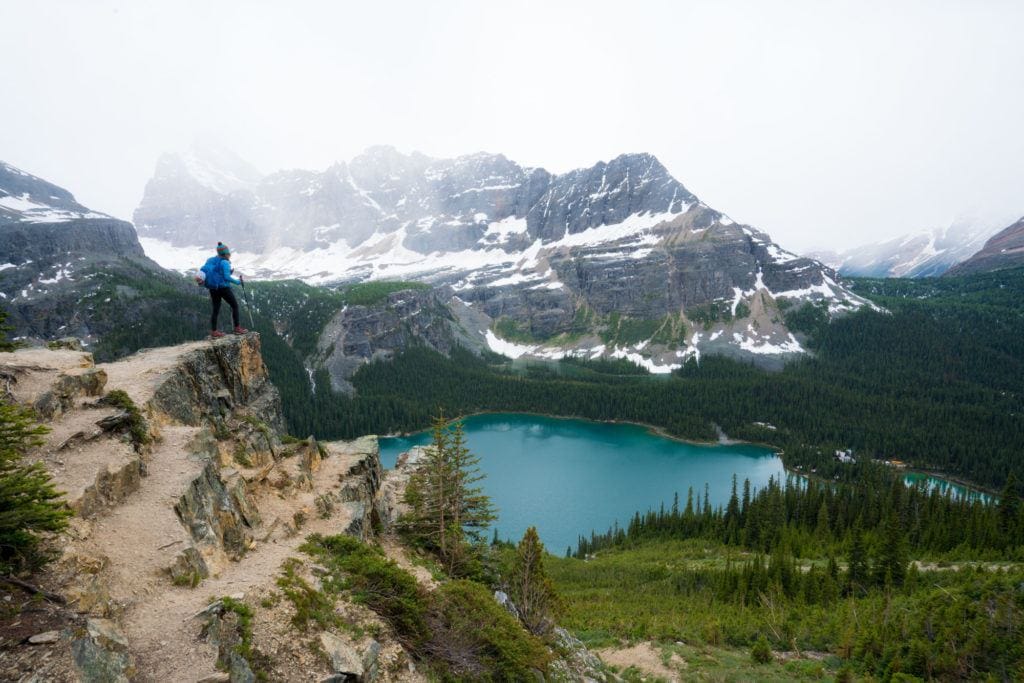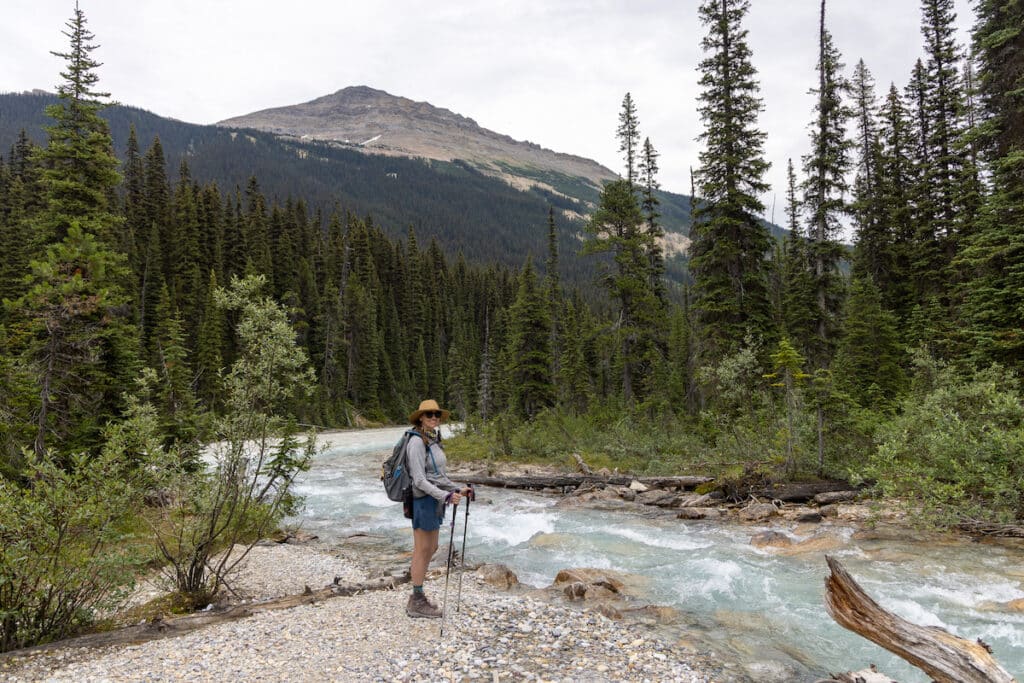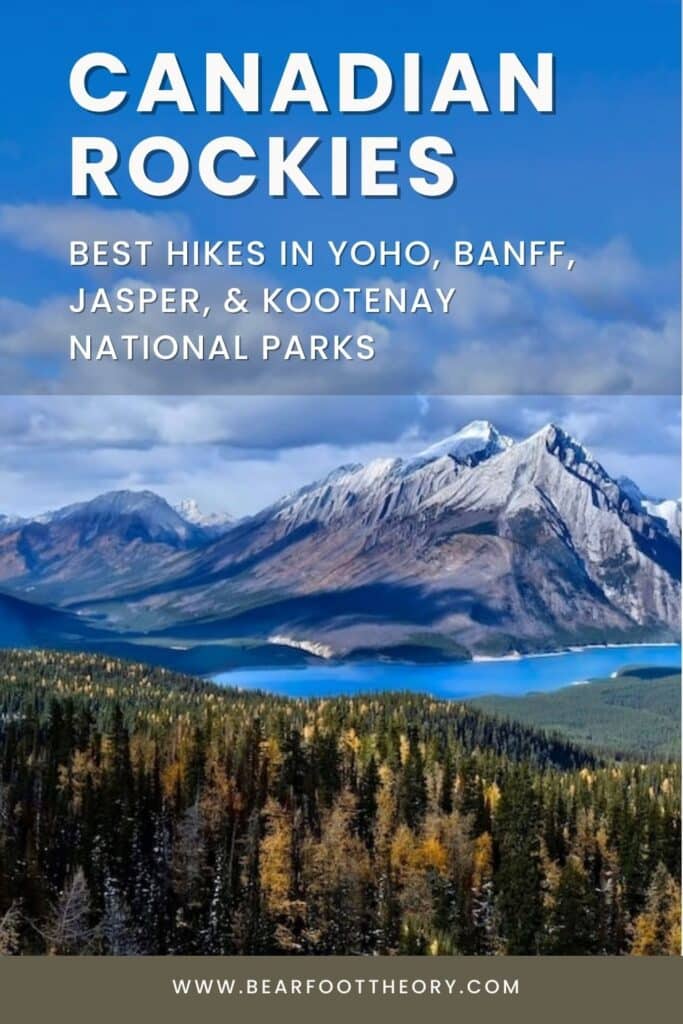8 Best Hikes in the Canadian Rockies (+ Local Tips!)
The Canadian Rockies are home to Canada’s prime mountain wilderness, so it’s not surprising that this mountain range attracts hikers from all around…

The Canadian Rockies are home to Canada’s prime mountain wilderness, so it’s not surprising that this mountain range attracts hikers from all around the world. I was lucky enough to live next to Banff National Park for about three years. During this time, I explored many of the best and most scenic hikes in the area. That being said, you could spend a lifetime here and never run out of trails to hike!
The Canadian Rockies are home to multiple national parks – Yoho, Banff, Jasper and Kootenay. On top of that, the Icefields Parkway drive between Banff and Jasper is one of the most scenic routes I’ve ever driven, full of incredible hiking opportunities. Picture snowy peaks, turquoise blue lakes, hot springs, luxury cabins, glittering glaciers, wildlife, and lush evergreen forests.
In this post, I share my favorite hikes in the Canadian Rockies. Whether you’re looking for a short, family-friendly stroll or a multi-day hiking adventure, I have something for you on this list.
This post may contain affiliate links.
1. Lake O’Hara Alpine Circuit
Trail Basics
Just the word O’Hara brings “oohs” from past hikers who trekked to this lake. And it makes sense. I felt a sense of awe when I first looked down at the sparkling emerald blue waters of Lake O’Hara straight from the top of the Alpine Circuit hike. This may be one of the best (if not the best) day hikes I’ve done in the Canadian Rockies. The route is simply divine!
Lake O’Hara is in Yoho National Park and it’s one of my favorite hiking destinations. The landscape is dotted with meadows, lookouts, ridge walks, turquoise lakes, and meticulously shaped stone trails.
What makes this hike even more special is that a quota system limits the number of hikers. You are not allowed to drive your own car to the trailhead. Instead, we had to book our Lake O’Hara reservations months in advance in order to take the bus to Lake O’Hara for day use and camping from mid-June to early October.
Reservations open from April for the summer season, but check the website for the exact date as the reservations fill up quickly. Cancellations do happen (this is how Kristen snagged a permit!), so don’t lose hope if you don’t manage to get your spot.
The 20-minute bus trip to the lake dropped us off at Le Relais, a wooden shelter where books and maps are sold and where the trail starts. I recommend hiking clockwise because you’ll tackle the steep ascent to Wiwaxy Gap when your legs are fresh. Along your route, we passed the stunning Lake Oesa and Opabin Lake. We also loved the sweeping views of some of the most iconic peaks in the Canadian Rockies.
If you want to extend your hike beyond a day trip, you can spend a few days either in the historic Elizabeth Parker alpine hut or in the Lake O’Hara campground. Since the hut sleeps 20 people, it’s a great way to meet new like-minded folks.
Read Kristen’s experience about camping at Lake O’Hara for a full three-day itinerary.
Shuttle Reservations
Reservations are only required for the inbound shuttle, outgoing buses fill on demand.

Save this post!
Enter your email & I'll send this post to your inbox! You'll also receive my weekly newsletter full of helpful advice for planning your adventures.
2. Johnston Canyon
Trail Basics
Johnston Canyon is possibly one of the most popular hikes in the Canadian Rockies and also one of my favorites. The canyon is beautiful all year round, but I find it especially enchanting in winter when the waterfalls freeze. The frozen canyon walls at Johnston Canyon become a winter wonderland that you can ice climb if that’s in your outdoor skillset.
I hiked the short and easy 1.1 km (0.7 mile) trail that took me up catwalks through a towering canyon to the 10-meter (33-foot) Lower Falls. As I kept walking, I reached the 30-meter (100-foot) Upper Falls. Passing through the tunnel was one of the highlights for me!

Continuing past the crowds, I ventured 5 km (3.1 miles) further to the Ink Pots – six green natural pools, which took me closer to four hours roundtrip. It’s a magical place and much quieter after the tourist rush of the canyon.
There is also nearby Johnston Canyon Campground. It’s a tranquil campground nestled in a pleasant forest less than 20 minutes from Banff. The scenery is spectacular, and the wildlife is abundant in and around this campground. A small creek flows right by the camping area.
After your hike, I recommend spending the rest of the day exploring Banff and eating at one of the many top-notch restaurants. While here, you shouldn’t miss out on taking a dip at Banff Upper Hot Springs.
If you plan to visit Johnston Canyon in winter, spending white Christmas in Banff combined with world-class skiing is especially magical.

Hiking Johnston Canyon in the Winter
Winter is a magical time to hike Johnston Canyon, but I recommend wearing microspikes if you do. The path can be icy and slippery. Microspikes add extra traction and reduce the risk of slipping or falling.
3. Skyline Trail
Trail Basics
If you’re looking for a multi-day hike in the Canadian Rockies, I recommend Skyline Trail. This stunning trail winds for about 44 km (27 miles) past some of the Jasper National Park’s most striking scenery.
The trail has the highest elevation gain in the park and the weather can be super unpredictable here, so I recommend packing extra layers. Unfortunately, this isn’t one of those hikes that you can do as a spontaneous weekend getaway. It requires a fair bit of planning.
The first thing I had to do was book the backcountry permit months in advance to hike the Skyline trail. On the plus side, it also meant the trail doesn’t get too overcrowded. Parks Canada limits the number of people it allows into these areas to protect the fragile terrain. All the reservations typically get snatched up within a few hours on the day that reservations open, so keep an eye on the website.
It’s a multi-day hike (2 or 3 days) with overnight stops at campsites* or the rustic Shovel Pass Lodge, which is halfway along the Skyline trail. The lodge was built in 1921, and I love its super cozy rustic vibe. Delicious home-cooked dinners and breakfasts plus lunch bags are included in the price. All the supplies and food ingredients are delivered to the Shovel Pass Lodge by horses twice a week to make this experience possible. How awesome is that!
Reservations for Shovel Pass Lodge open in November for the following year.

Tips for hiking Skyline Trail
4. Sulphur Skyline Trail
Trail Basics
Not to be mistaken with Skyline Trail that I mentioned above, the 8km (5-mile) Sulphur Skyline Trail is another wonderful scenic Canadian Rockies hike in Jasper.
From the summit, I could see the Fiddle River Valley, the Miette Mountain Range, and the cliffs of Asher Ridge.
This trail is particularly lovely in the autumn when all the colorful leaves pop up. However, I might be biased because I absolutely adore Canadian autumn!
I found Sulphur Skyline Trail to be a fairly challenging hike, with 700 m (2,297 feet) of elevation gain. The first 2 km (1.4 miles) is a steady climb and the trail becomes very rocky and steep near the top.

My favorite part of this hike, though, is soaking at Miette Hot Springs after you return back down the trail. The warm water feels super rewarding and relaxing. These are paid hot springs, but the entrance fee is worth it for a few hours of bliss.
Oh, and did I mention they’re the hottest hot springs in the Canadian Rockies? The hot springs’ natural temperature is 54°C (129°F) but the pool is cooled down to a comfortable 40°C (104°F).
Also, keep your eyes peeled for bighorn sheep on the road that leads to Miette Hot Springs.
Tips for hiking Skyline Sulphur Trail
5. Floe Lake
Trail Basics
Floe Lake is one of the highlights on this hike, but the entire trail has stunning views. Before putting it on your hike-it list, though, it’s important to know that the hike to Floe Lake isn’t easy. It requires about 20km (12.6 miles) of walking, but I think it’s worth the effort and sweat!
Once you get to the lake, you can reward yourself with a dip in the water to cool down if it’s a hot summer day. At the top, you’ll also find Floe Lake Warden Patrol Cabin in its spectacular setting close to the shores of Floe Lake.

The hike is manageable within a day, but I suggest staying overnight at Floe Lake Campground if you have two days. The lake is the most photogenic in the morning, too, so spending the night will allow you to enjoy the early morning views. Keep in mind that the Floe Lake Campground is the most popular backcountry campground in Kootenay National Park, so book as soon as the reservations open each year.
If you can’t get enough of the Canadian Rocky Mountains’ natural beauty, you can also make it into a multi-day trip along The Rockwall Trail.
Tip: The trail to Floe Lake leads largely through a burn area with little to no shade, which means full sun exposure on a hot day. Bring lots of water, sun protection, and sunblock. (A massive fire ravaged this area in 2003).
6. Tent Ridge
Trail Basics
Tent Ridge is my absolute favorite hike in Kananaskis. At the top, you get 360 jaw-dropping views over Spray Valley, the reservoir, and the highest peaks in Kananaskis Country.
But be prepared to work for it! There are a few technical portions where you have to scramble and climb rocks, which can be a bit nerve-wracking and intimidating for newer hikers. Hiking poles are really helpful to have along this section. I recommend doing the hike clockwise because the counterclockwise direction is way more challenging. If you can, go for a sunrise. You won’t regret it!
Another thing to keep in mind is that the road leading to the trailhead isn’t paved, so get ready for a 40-minute drive on a gravel road with many potholes. Also, there are no outhouses along the trail, but there is one at Spray Lake, which you’ll pass 5-10 minutes before getting to the trailhead.

7. Lake Agnes Trail
Trail Basics
There are dozens of popular day hikes in Banff National Park to choose from, but Lake Agnes is one of the best hikes in the Canadian Rockies. In autumn, the yellows of the larch season are especially beautiful.
Fairmont Chateau Lake Louise Hotel is a starting point for several short, moderately strenuous Canadian Rockies hiking trails, including this 7.4 km (4.6-mile) return hike to Lake Agnes or, as some like to call it, “The Lake in the Clouds”.
Along the trail, we passed through an old-growth forest and a waterfall before ending at Lake Agnes teahouse, where we stopped for tea and dessert (bring cash). The teahouse also serves soups, sandwiches, and snacks. I love, that you can enjoy tea on top of a mountain with glorious lake views. I mean, what’s there not to love about sipping tea and appreciating the wonderful view?
For more incredible mountain views, we kept walking down the trail towards Beehives. From the Lake Agnes Tea House, you’ll follow the well-signed trail as it heads back down to Lake Louise, passing Mirror Lake along the way.
Tip: In 2021, Parks Canada implemented a mandatory parking fee for the Lake Louise parking lot from mid-May to mid-October. Alternatively, you can take a shuttle. Learn more about Lake Louise parking and shuttle.

8. Emerald Lake Loop
Trail Basics
On my first visit to Emerald Lake, I remember thinking to myself, I understand how it got its name. Emerald-green water surrounded by towering mountains makes this lake nothing short of extraordinary. It’s easily one of the most photogenic destinations in all of Canada.
The 5km (3 miles) loop around the lake is mostly flat and easy to hike. I thought the best views were from the western shoreline. If you feel adventurous, you can extend your walk and climb towards Emerald Basin. Alternatively, you can escape the crowds by renting a canoe and paddling across the lake.
When you’re done with your hike or paddle, grab a coffee, ice cream, a house-baked cookie, or a light lunch at Emerald Lake Lodge, which has an outdoor patio restaurant overlooking the lake.

You can also explore the area further by taking the short trail (800 meters (0.5 miles) to Hamilton Falls. The trail continues to Hamilton Lake which is quieter and way less crowded than Emerald Lake. It’s a steep hike so a good cardio workout.
Tip: Don’t miss the chance to see Canada’s highest waterfall at 373 meters – Takakkaw Falls, which is only half an hour’s drive from Emerald Lake. The falls are easily accessible from the parking lot.
Other Amazing Hikes in the Canadian Rockies
Looking for more hikes? Here are a few more of my favorites to add to your list:

Wildlife Safety in the Canadian Rockies
Hiking in the Canadian Rockies is not only about the stunning scenery but also unforgettable wildlife viewing opportunities. From herds of elk and moose to black bears and mountain goats, you name it.
Here are a few tips about staying safe and respecting wildlife in the Canadian Rockies:
Useful Tips for Hiking in the Canadian Rockies
New to hiking in the Canadian Rockies? Here are a few tips to help you plan your trip and stay safe on the trails:
READ NEXT
Planning a Canadian Rockies road trip? Check out these posts to help plan your adventure:
Save this post to Pinterest
Have you hiked in the Canadian Rockies? What are your favorite treks? Which ones are on your bucket list? Leave a comment below!





